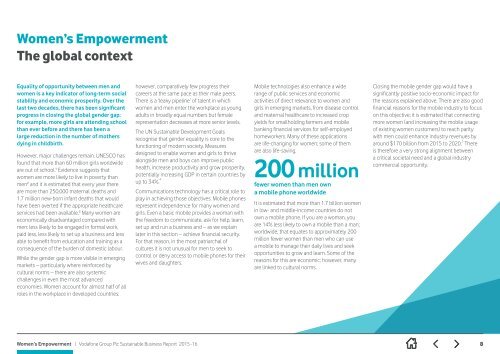Women’s Empowerment
grECVPt
grECVPt
You also want an ePaper? Increase the reach of your titles
YUMPU automatically turns print PDFs into web optimized ePapers that Google loves.
<strong>Women’s</strong> <strong>Empowerment</strong><br />
The global context<br />
Equality of opportunity between men and<br />
women is a key indicator of long-term social<br />
stability and economic prosperity. Over the<br />
last two decades, there has been significant<br />
progress in closing the global gender gap:<br />
for example, more girls are attending school<br />
than ever before and there has been a<br />
large reduction in the number of mothers<br />
dying in childbirth.<br />
However, major challenges remain. UNESCO has<br />
found that more than 60 million girls worldwide<br />
are out of school.¹ Evidence suggests that<br />
women are more likely to live in poverty than<br />
men² and it is estimated that every year there<br />
are more than 250,000 maternal deaths and<br />
1.7 million new-born infant deaths that would<br />
have been averted if the appropriate healthcare<br />
services had been available.³ Many women are<br />
economically disadvantaged compared with<br />
men: less likely to be engaged in formal work,<br />
paid less, less likely to set up a business and less<br />
able to benefit from education and training as a<br />
consequence of the burden of domestic labour.<br />
While the gender gap is more visible in emerging<br />
markets – particularly where reinforced by<br />
cultural norms – there are also systemic<br />
challenges in even the most advanced<br />
economies. Women account for almost half of all<br />
roles in the workplace in developed countries;<br />
however, comparatively few progress their<br />
careers at the same pace as their male peers.<br />
There is a ‘leaky pipeline’ of talent in which<br />
women and men enter the workplace as young<br />
adults in broadly equal numbers but female<br />
representation decreases at more senior levels.<br />
The UN Sustainable Development Goals<br />
recognise that gender equality is core to the<br />
functioning of modern society. Measures<br />
designed to enable women and girls to thrive<br />
alongside men and boys can improve public<br />
health, increase productivity and grow prosperity,<br />
potentially increasing GDP in certain countries by<br />
up to 34%. 4<br />
Communications technology has a critical role to<br />
play in achieving those objectives. Mobile phones<br />
represent independence for many women and<br />
girls. Even a basic mobile provides a woman with<br />
the freedom to communicate, ask for help, learn,<br />
set up and run a business and – as we explain<br />
later in this section – achieve financial security.<br />
For that reason, in the most patriarchal of<br />
cultures it is not unusual for men to seek to<br />
control or deny access to mobile phones for their<br />
wives and daughters.<br />
Mobile technologies also enhance a wide<br />
range of public services and economic<br />
activities of direct relevance to women and<br />
girls in emerging markets, from disease control<br />
and maternal healthcare to increased crop<br />
yields for smallholding farmers and mobile<br />
banking financial services for self-employed<br />
homeworkers. Many of these applications<br />
are life-changing for women; some of them<br />
are also life-saving.<br />
200 million<br />
fewer women than men own<br />
a mobile phone worldwide<br />
It is estimated that more than 1.7 billion women<br />
in low- and middle-income countries do not<br />
own a mobile phone. If you are a woman, you<br />
are 14% less likely to own a mobile than a man;<br />
worldwide, that equates to approximately 200<br />
million fewer women than men who can use<br />
a mobile to manage their daily lives and seek<br />
opportunities to grow and learn. Some of the<br />
reasons for this are economic; however, many<br />
are linked to cultural norms.<br />
Closing the mobile gender gap would have a<br />
significantly positive socio-economic impact for<br />
the reasons explained above. There are also good<br />
financial reasons for the mobile industry to focus<br />
on this objective; it is estimated that connecting<br />
more women (and increasing the mobile usage<br />
of existing women customers) to reach parity<br />
with men could enhance industry revenues by<br />
around $170 billion from 2015 to 2020. 5 There<br />
is therefore a very strong alignment between<br />
a critical societal need and a global industry<br />
commercial opportunity.<br />
<strong>Women’s</strong> <strong>Empowerment</strong> | Vodafone Group Plc Sustainable Business Report 2015 -16 8


